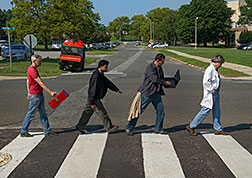- Number 397 |
- September 16, 2013
Searching for charge 'stripes' in superconductors

Brookhaven scientists are making strides
toward uncovering the role of
"charge stripes" in superconductivity, the
ability of some materials to carry electric
current with no energy loss.
Scientists at DOE's Brookhaven Lab have identified a series of clues that particular arrangements of electrical charges known as "stripes" may play a role in superconductivity—the ability of some materials to carry electric current with no energy loss. But uncovering the detailed relationship between these stripe patterns and the appearance or disappearance of superconductivity is extremely difficult, particularly because the stripes that may accompany superconductivity are very likely moving, or fluctuating.
As a step toward solving this problem, the Brookhaven team used an indirect method to detect fluctuating stripes of charge density in a material closely related to a superconductor. The research identifies a key signature to look for in superconductors as scientists seek ways to better understand and engineer these materials for future energy-saving applications.
The scientists started their experiments on a material they knew had a static striped pattern below a certain temperature, then studied what happened as the temperature rose to see whether the stripes would either disappear or persist but start to move. They used a beam of neutrons at the Los Alamos Neutron Science Center to get information about the positions of the atoms in ground up crystals of the material, and used that to indirectly test for charge density modulations.
In the static striped arrangement, the atoms are displaced from their average positions in a regular way in response to the electronic modulation. With increasing temperature, though the static stripe order disappeared, the displacements from average structure persisted. That led the scientists to conclude by inference that the striped pattern of charge density also remained, even though it was no longer static.
The next step: Return to searching for stripes in superconductors by looking for a similar diffraction-scattering signature. That search should lead to better understanding of the role of stripes in superconductivity, and possibly to new approaches to engineer advanced superconductors for energy applications.[Karen McNulty Walsh, 631.344.8350,
kmcnulty@bnl.gov]
